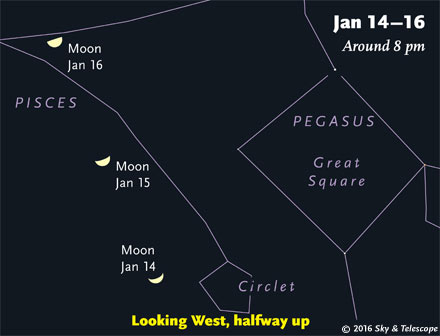
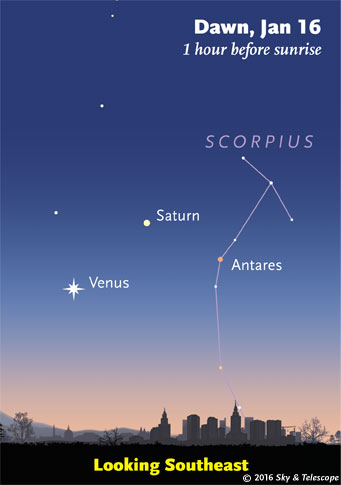
Friday, January 15
• After dinnertime in January, the Great Square of Pegasus balances on one corner high in the west. Tonight the Moon (nearly first-quarter) marks the way by shining to the left of it, as shown here.
The whole Pegasus-Andromeda constellation complex runs all the way from near the zenith (Andromeda's foot) down through the Great Square (Pegasus's body) to somewhat low in the west (Pegasus's nose).
Saturday, January 16
• First-quarter Moon (exact at 6:26 p.m. EST). The Moon shines in dim Pisces upper left of the Great Square of Pegasus, as shown above. Does the half-lit Moon look just a trace bigger than usual? It's about at perigee.
Sunday, January 17
• If you don't know Kemble's Cascade, it's a lovely binocular asterism in Camelopardalis north of Perseus now high overhead. It's a straight stream of mostly faint stars 2° long, running northwest to southeast. You can use the finder chart in Gary Seronik's Binocular Highlight on page 43 of the January Sky & Telescope. Most of its stars are too faint (7th or 8th magnitude) to show on that chart, but the black circle there is centered on its 5th-magnitude middle star.
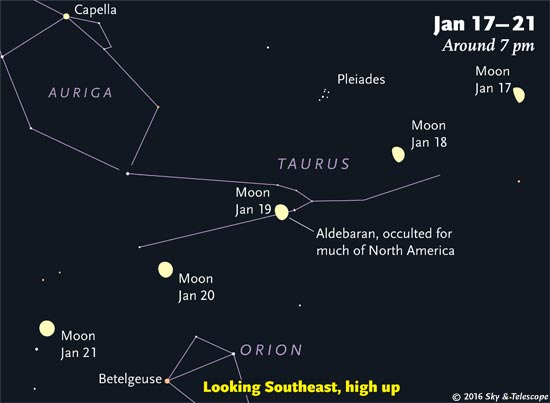
Monday, January 18
• Jupiter's outer big moon, Callisto, disappears into eclipse by Jupiter's shadow — slowly, gradually — around 12:32 a.m. Tuesday morning EST; 10:32 p.m. Monday evening MST.
• Bright Capella high overhead, and equally bright Rigel in Orion's foot, are at almost the same right ascension. This means they cross your sky’s north-south meridian at almost the same time (around 9 or 10 p.m. now, depending on how far east or west you live in your time zone). So whenever Capella passes its very highest, Rigel marks true south over your landscape.
Tuesday, January 19
• The dark limb of the waxing gibbous Moon occults Aldebaran this evening for most of North America. See the time-prediction maps in the January Sky & Telescope, page 49. You can also get local timetables for the star's disappearance and reappearance. The Moon will be 82% sunlit.
Wednesday, January 20
• Sirius twinkles brightly after dinnertime below Orion in the southeast, far below the Moon. Sometime around 8 or 9 p.m., depending on your location, Sirius shines precisely below fiery Betelgeuse in Orion's shoulder. How accurately can you time this event for your location, perhaps using a plumb bob or the vertical edge of a building? Sirius leads early in the evening, Betelgeuse leads later.
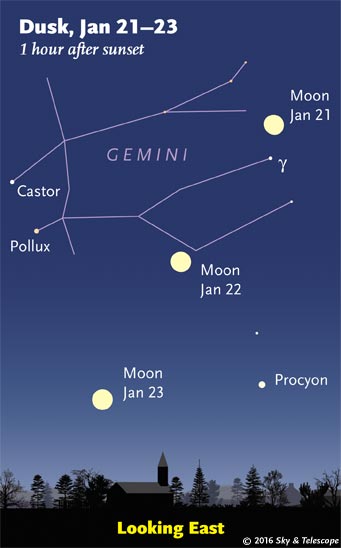
Thursday, January 21
• Tonight the 9.9-magnitude asteroid 115 Thyra will briefly occult a 9.0-magnitude star near the Beehive cluster in Cancer for telescope users along a narrow track from southern New Jersey through the San Diego area. Watch them merge before their combined light suddenly drops by 1.3 magnitudes for up to 7 seconds. Track map, finder charts, time predictions.
Friday, January 22
• The nearly-full Moon shines in Gemini this evening, with Castor and Pollux to its upper left and brighter Procyon to its lower right, as shown here.
• On the other side of the sky, the big Northern Cross of Cygnus plants itself upright on the northwest horizon soon after the end of twilight.
Saturday, January 23
• Full Moon (exact at 8:46 p.m. EST). As the Moon climbs the eastern sky this evening, look for Pollux and Castor above it and Procyon to its right. It's currently 4° south of the ecliptic; in a telescope, look for features on its northern limb casting extremely thin shadows even at the time of full Moon.
__________________________
Want to become a better astronomer? Learn your way around the constellations. They're the key to locating everything fainter and deeper to hunt with binoculars or a telescope.
This is an outdoor nature hobby. For an easy-to-use constellation guide covering the whole evening sky, use the big monthly map in the center of each issue of Sky & Telescope, the essential guide to astronomy.
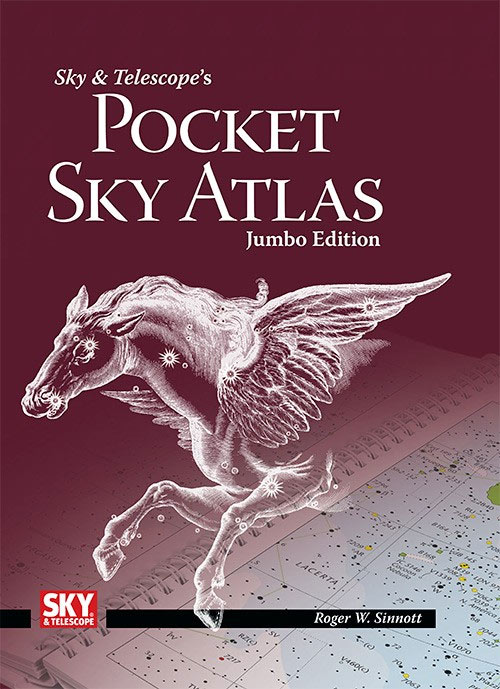
Once you get a telescope, to put it to good use you'll need a detailed, large-scale sky atlas (set of charts). The basic standard is the Pocket Sky Atlas (in either the original or new Jumbo Edition), which shows stars to magnitude 7.6.
Next up is the larger and deeper Sky Atlas 2000.0, plotting stars to magnitude 8.5, nearly three times as many. Next up, once you know your way around, is the even larger Uranometria 2000.0 (stars to magnitude 9.75). And read how to use sky charts with a telescope.
You'll also want a good deep-sky guidebook, such as Sue French's Deep-Sky Wonders collection (which includes its own charts), Sky Atlas 2000.0 Companion by Strong and Sinnott, or the bigger Night Sky Observer's Guide by Kepple and Sanner.
Can a computerized telescope replace charts? Not for beginners, I don't think, and not on mounts and tripods that are less than top-quality mechanically (meaning heavy and expensive). As Terence Dickinson and Alan Dyer say in their Backyard Astronomer's Guide, "A full appreciation of the universe cannot come without developing the skills to find things in the sky and understanding how the sky works. This knowledge comes only by spending time under the stars with star maps in hand."
This Week's Planet Roundup
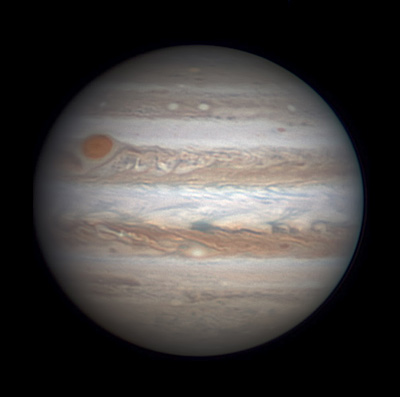
Mercury is buried in the glow of sunrise.
Saturn (magnitude +0.5) and brilliant Venus (–3.9) are low in the southeast in early dawn. Venus is getting lower, while Saturn is moving higher to Venus's upper right. They're 8° apart on January 16th and 16° apart by the 23rd. Throughout the week, Antares (magnitude +1.1) shines 7° lower right of Saturn.
Mars (magnitude +1.1, in eastern Virgo), glows high in the south in early dawn. This week it moves from 13° to 17° left of Spica, its twin for brightness but not for color!
Jupiter (magnitude –2.3, between Leo and Virgo) rises in the east around 9 or 10 p.m., shines highest in the south around 3 or 4 a.m., and moves over to dominate the southwestern sky by early dawn. It's on its way to opposition March 8th.
Uranus (magnitude +5.8, in Pisces) is still well up in the southwest just after dark. Finder chart.
Neptune (magnitude +7.9, in Aquarius) is getting very low in the west-southwest after dark.
__________________________
All descriptions that relate to your horizon — including the words up, down, right, and left — are written for the world's mid-northern latitudes. Descriptions that also depend on longitude (mainly Moon positions) are for North America.
Eastern Standard Time (EST) is Universal Time (UT, UTC, or GMT) minus 5 hours.
__________________________
“This adventure is made possible by generations of searchers strictly adhering to a simple set of rules. Test ideas by experiments and observations. Build on those ideas that pass the test. Reject the ones that fail. Follow the evidence wherever it leads, and question everything. Accept these terms, and the cosmos is yours.”
— Neil deGrasse Tyson
 0
0








Comments
You must be logged in to post a comment.